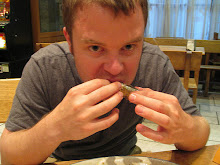 Spaniards seem to love themselves some Barak Obama. Once they discover I'm American, they waste no time telling me how much they like him and how much better he is than W. Not that I disagree or anything, but when I mention Zapatero's flaws the tables turn quickly. They ensure me that I simply don't understand Spanish politics.
Spaniards seem to love themselves some Barak Obama. Once they discover I'm American, they waste no time telling me how much they like him and how much better he is than W. Not that I disagree or anything, but when I mention Zapatero's flaws the tables turn quickly. They ensure me that I simply don't understand Spanish politics. Digression aside, the proprietor of Restaurante Los Zagales decided to honor our new president by designing a pincho based on his electoral victory. Enter "Obama en La Casablanca"! Every year there are pincho competitions all over Spain. National competitions, regional competitions, city competitions, etc...Los Zagales is pretty famous, having won numerous awards at every level. So far "Obama" has won the gold medal in the city of Valladolid, but the important national competitions are still on the horizon.
So what is "Obama en La Casablanca" you ask? Well, as you can see above, it arrives in a white-domed ceramic dish. That symbolizes the White House for those of you who didn't get it.
 The dish itself consists of a disc of crisp puff pastry, topped with a BARELY set egg, truffled mushroom cream sauce, and burned (yes burned) shards of potato. My interpretation of the dish is that the egg represents the egg of reform Obama is attempting to lay in American society, while the puff pastry represents the dangerously fragile state of the U.S. economy on which he is trying lay said egg. The rich truffled cream sauce represents Obama's first-class (and expensive) educational background. Finally, the blackened shards of potato represent Obama himself. Maybe I'm reading too much into the dish though. What do you think?
The dish itself consists of a disc of crisp puff pastry, topped with a BARELY set egg, truffled mushroom cream sauce, and burned (yes burned) shards of potato. My interpretation of the dish is that the egg represents the egg of reform Obama is attempting to lay in American society, while the puff pastry represents the dangerously fragile state of the U.S. economy on which he is trying lay said egg. The rich truffled cream sauce represents Obama's first-class (and expensive) educational background. Finally, the blackened shards of potato represent Obama himself. Maybe I'm reading too much into the dish though. What do you think?All said, this pincho is simply fabulous. It is incredibly rich and the oozing yolk combines with the cream sauce to make perfect bread-dipping fodder. Most surprising however, are the burned potatoes. They taste absolutely amazing and not scorched in the slightest. The bartender wouldn't tell me how they make them but I intend on finding out. The shatteringly crisp bits of salty potato are a perfect counterpoint to the creamy sauce.






